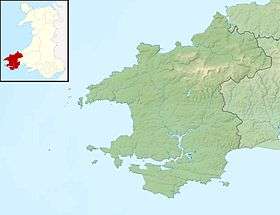Carnllundain
Carnllundain or Carn Llundain[4] is the highest hill of Ramsey Island in Pembrokeshire, Wales.
| Carnllundain | |
|---|---|
 | |
| Highest point | |
| Elevation | 136 m (446 ft) [1] |
| Prominence | 136 m (446 ft) [1] |
| Listing | HuMP[2] |
| Coordinates | 51°51′43″N 5°20′51″W |
| Naming | |
| Language of name | Welsh |
| Geography | |
 Carnllundain | |
| OS grid | SM6961123460 |
| Geology | |
| Age of rock | Cretaceous[3] |
| Mountain type | rhyolite |
| Climbing | |
| First ascent | ancestral |
| Easiest route | Hike |
Geography
The 136-metre (446 ft) high hill stands near the west coast of Ramsey island. The top of the hill is marked by a large cairn and a trig point.[5] On clear days it offers a view of a long stretch of Pembrokeshire coastline, Skomer Island and, across the Irish Sea, of SW Ireland.[6]
History
The area around the hill is of archaeological interest and hosts some Bronze Age stone wall remains.[4]
Carn Llundain along with Carn Ysgubor, located near the northern shore of Ramsey Island, during middle ages offered a useful landmark to seafaring pilgrims heading to St Davids.[7]
Access to the summit

The summit of the hill can be reached with a short waymarked diversion from the trail round the island;[6] no special hiking ability is required, but wearing proper outdoor clothing is advisable.
Conservation
Carnllundain along with Ramsey Island is owned and managed by the Royal Society for the Protection of Birds (RSPB)[8]
References
![]()
- "Carnllundain". Ordnance Survey Ireland. Retrieved 2017-03-25.
- "Carnllundain". The Mountain Guide. Retrieved 2017-03-25.
- "Geological History of Pembrokeshire". Pembrokeshire Online Ltd. Retrieved 2017-03-25.
- "Carn llundain". Coflein. Royal Commission on the Ancient and Historical Monuments of Wales. Retrieved 2017-03-25.
- "Trig point on Ramsey Island". Retrieved 2017-03-23.
- "Ramsey Island, Pembrokeshire". Pembrokeshire County Council. Retrieved 2017-03-25.
- "Ramsey Island". Pembrokeshire Coast National Park. Retrieved 2017-03-25.
- "About Ramsey Island". The Royal Society for the Protection of Birds. Retrieved 2017-03-25.